MY WORK
View these short demos to get an idea of what’s possible
Breaking News
I’ve recently completed a case study of an inclusion eLearn I designed and developed for the National Citizen Service. Select the ‘CASE STUDY’ button to explore that study.
OVERVIEW OF PAGE AND DEMOS
VIDEO TOUR OF PORTFOLIO
DEMOS ON THIS PAGE
HARASSMENT CASE DEMO
THE PROBLEM
Human Resources staff are coming to incorrect conclusions and mishandling cases of alleged harassment at work. This has resulted in several employees resigning and claiming constructive dismissal.
All these individuals have won their cases against your organisation when they went to an Employment Tribunal.
The reasons for incorrect conclusions range from staff not understanding the law, to individual biases.
VIDEO TOUR - HARASSMENT CASE DEMO
THE DETAIL
Goal
To help HR staff evaluate the evidence for each alleged harassment case they deal with. This includes them understanding the law related to harassment and helping them reflect on any biases they may have that influence their view.
Solution
An eLearning scenario that allows HR staff to practice the kind of case that they may get at work. They’ll have to understand the law and reflect on their own thoughts and biases to conclude whether harassment has taken place. Following their evaluation of the case, they get direct feedback on whether their conclusion was correct or incorrect and why.
Outcome
HR staff has a better understanding of the main points of law they need to consider in cases of alleged harassment. Additionally, they can self-reflect and consider the impact their own biases and opinions might have on their decisions. HR staff handle cases of alleged harassment more sensitively and there is a decrease in tribunal cases and an increase in employee satisfaction.
SKILLS & TOOLS
SKILLS
- Instructional Design
- eLearning Development
- Graphic Design
TOOLS
- Articulate Storyline 360
- Adobe Photoshop
- Adobe Audition


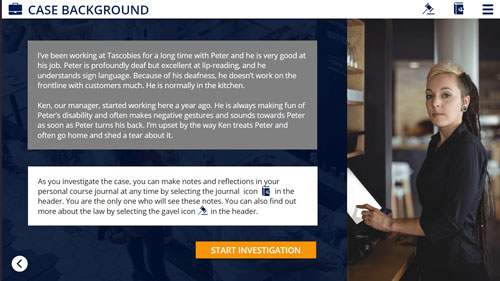

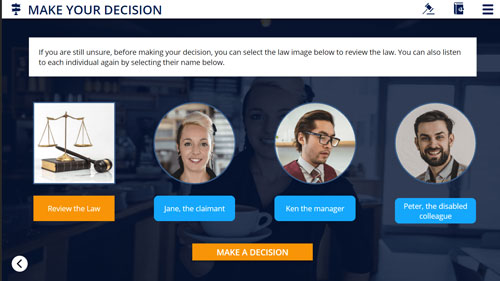

CUSTOMER SERVICE TRAINING DEMO
THE PROBLEM
The size of the customer service team has increased recently. At the same time as the increase in personnel, there has been an increase in negative google reviews. Many of these reviews mention customer service being poor.
The negative reviews have affected profits as, in a recent survey, 10% of potential customers who chose not to buy cited the negative google reviews as the reason.
Most of the negative feedback focuses on customer service representatives not listening and being rude.
VIDEO TOUR - CUSTOMER SERVICE TRAINING DEMO
THE DETAIL
Goal
To improve the way customer service reps handle phone calls, especially those from customers that are already angry or have a potential issue they want resolving.
Customers should go away from each call feeling they have been heard, dealt with politely, and their issues handled professionally and appropriately.
Solution
An eLearning scenario that allows customer service reps to practice handling difficult conversations with customers.
The customer service rep’s response will determine the route that the scenario takes. If the rep responds correctly, the customer will respond positively. If the rep answers incorrectly, the customer will become angrier.
The feedback at the end will detail what the rep did correctly or incorrectly to trigger the response they received from the customer.
Outcome
Customer service reps can deescalate conversations with angry customers while remaining professional and making sure the customer feels listened to.
Even if the customer does not get what they wanted, they feel positive about the interaction and are more likely to write a positive review or speak positively about their experience.
SKILLS & TOOLS
SKILLS
- Instructional Design
- eLearning Development
- Graphic Design
TOOLS
- Articulate Storyline 360
- Adobe Illustrator
- Adobe Audition

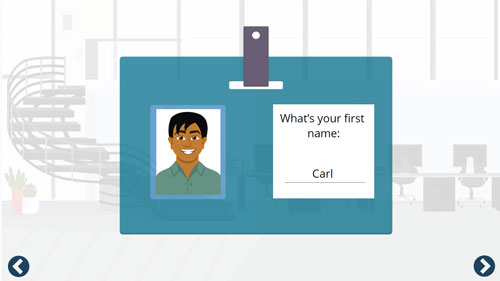
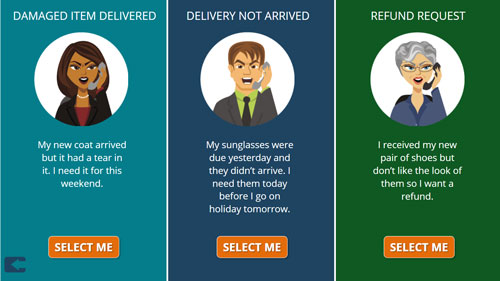


TEST YOUR SPELLING SKILLS DEMO
Caveat: Most of my work focuses on adult learners; however, I created this fun little demo to give an example of how gamification elements such as sounds, and quizzes with feedback can be built into eLearning.
These elements can be easily adjusted and transferred into adult learning contexts.
THE PROBLEM
Children between the ages of 6 and 10 are struggling to spell basic words and to understand some of the logic behind spelling words correctly.
VIDEO TOUR - TEST YOUR SPELLING DEMO
THE DETAIL
Goal
To improve the spelling of commonly misspelt words by children in the specified age group. Children should be able to recognize similarities between these words and other commonly misspelt words so that they can spell other words correctly as well.
Solution
A fun 10 question quiz that contains 10 words that are regularly misspelt.
The quiz will be engaging and fun from the start and give children the opportunity to hear sounds that indicate when they have answered correctly or incorrectly.
The imagery also reflects a fun game with the facial expressions and body language of illustrated characters changing, depending on whether the correct or incorrect answer has been given.
The feedback will be positively framed to encourage the child to continue, and to work at improving.
Outcome
Children improve in their understanding of basic spelling syntax and thus improve their spelling beyond just the 10 words in the quiz.
Because of the gaming feel, children enjoy the experience and want to test themselves and improve their score until they receive 10 out of 10.
SKILLS & TOOLS
SKILLS
- Instructional Design
- eLearning Development
- Graphic Design
TOOLS
- Articulate Storyline 360
- Adobe Illustrator



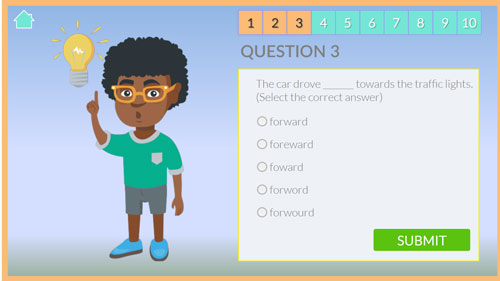

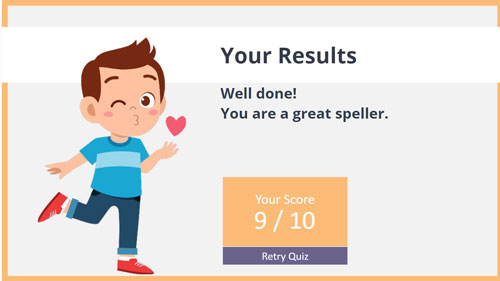
Ready to talk?
To schedule a free, no-strings 30-minute consultation, simply select the ‘LET’S TALK’ button and provide me with the requested details about your project.
